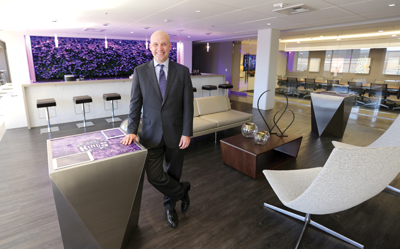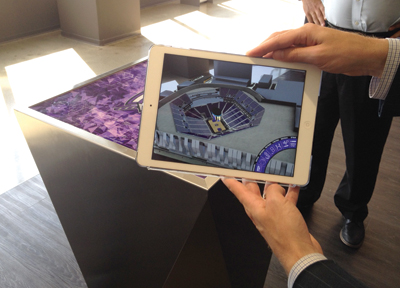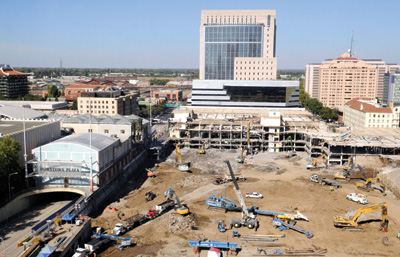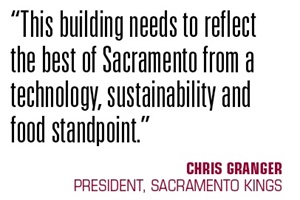At Sixth and L streets in downtown Sacramento, residents recently set up lawn chairs on their lunch hours to watch demolition crews level an empty shopping mall. The attraction isn’t what used to be there, but what’s coming next: the Kings’ $477 million arena.
“It’s the greatest show in Sacramento,” Kings President Chris Granger said. “There’s an unbridled enthusiasm for this project and what it means for Sacramento and the revitalization of downtown.”
 |
The Kings’ Chris Granger at the team’s Experience Center arena marketing center.
Photo by: SACRAMENTO KINGS
|
It’s easy to understand their excitement, considering the Kings were bound for Seattle last year until a last-ditch effort by Kevin Johnson, Sacramento’s mayor and a former NBA point guard, saved the day. Johnson and the new ownership group, headed by software titan Vivek Ranadivé, struck a public-private partnership to pay for building the arena and a new practice facility, plus 1.5 million square feet of mixed-use development. Two years from now, in October 2016, the arena will be the first piece to open in a portion of downtown that’s seen better days.
The arena itself, the NBA’s first new facility to open since Barclays Center in 2012, is expected to raise the bar for sports technology in the Silicon Valley region and put a spin on flexibility to attract special events in one of the NBA’s smallest markets.
Granger, the NBA’s former executive vice president of team marketing and business operations, is intimately familiar with the league’s 30 arenas, and this much he guarantees: The Kings’ new facility won’t be Barclays Center 2.0.
“As much as I love the Barclays Center, this is Sacramento and this building needs to reflect the best of Sacramento from a technology, sustainability and food standpoint,” he said. “You should be able to walk this building and know you are in Sacramento. Period. And that’s what we’re after.”
A tour through the Experience Center, the Kings’ arena marketing center in a building overlooking the arena site, showcases some of the tech gadgets the team is using to sell premium seats and heighten the fan experience.
 |
Technology turns a flat surface into a 3-D version of the seating bowl on a table.
Photo by: DON MURET / STAFF
|
Potential customers can strap on virtual reality goggles to put themselves at midcourt with Kings center DeMarcus Cousins. The technology is supplied by Oculus, a firm Facebook recently bought for $2 billion.
Instead of building a small model of the arena to show prospective buyers, the Kings tapped into augmented reality to up the wow factor. Ben Gumpert, the Kings’ chief marketing officer, and his staff open the team’s arena application on a tablet and wave it over a flat surface embedded with the technology to activate a 3-D version of the seating bowl on the mobile device.
Lending to the coolness, the Kings’ business cards contain the same augmented reality feature. It’s called Vuforia, a mobile platform made by Qualcomm, said Ryan Montoya, the team’s senior vice president of strategy, innovation and technology.
Wireless phone charging stations, an emerging technology, and the newest remote control devices for TVs in the suites — equipped with buttons to control views tied to Kings broadcasts, contact a live concierge and get advanced game statistics — are also part of the Experience Center.
A drone camera periodically flies above the construction site, providing real-time images as part of the team’s website tracking arena development.
“We’re very lucky with our ownership group,” Granger said. “Vivek and [Qualcomm CEO and Kings co-owner] Paul Jacobs are already at the leading edge of mobility and connectivity. They can tell us what’s going to happen in the next few years, so it aids in the design process.”
The arena design itself, based on feedback from more than 20,000 fans, is heavy on glass for a transparent look. The Kings wanted an “extroverted” building compared with other arenas, where “the doors shut, you’re looking into the bowl and that’s all you can see,” Granger said.
Small and intimate are key features. The arena will fit 17,500, including standing room. There are 34 suites, four more than Sleep Train Arena but still the smallest number in the NBA. In a city with no Fortune 1,000 companies, the Kings have sold two-thirds of the suites, priced at $250,000 to $500,000 a year, Granger said. The marketing of 48 lofts comes next, priced at $100,000 to $200,000 a year. Those units come with eight cushioned chairs that can be moved around the premium space, similar to your living room. There are three lounges at event level tied to 1,200 club seats, but no bunker suites.
“There’s a sense of community and spirit in Sacramento that we’re trying to continue to kindle over time,” Granger said. “The nature of the bunker is counter to how people interact here.”
The giant glass doors framing the main entrance, the arena’s signature element, measure 150 feet wide and 50 feet tall. They operate like the doors on an airplane hangar and open to a large outdoor plaza with space for up to 10,000 spectators.
 |
The arena project is bringing new activity to a corner of downtown Sacramento.
Photo by: DENNIS MCCOY / SACRAMENTO BUSINESS JOURNAL
|
The massive doors allow AECOM, the same architect for Barclays Center, to do something in Sacramento that to its knowledge has never been done in a sports and entertainment venue: effectively design two stage ends in the horseshoe-shaped seating bowl, said Jon Niemuth, the firm’s principal-in-charge.
For most concerts, stage end will be in the horseshoe’s open end, Granger said. By opening the doors and putting the stage toward the back of the arena in the closed end with a few thousand seats set up on the floor, the building could further push the summer-festival feel while accommodating more than 20,000 concertgoers.
“There are some interesting things from an amphitheater-style setup we can do given the climate here,” Granger said. “We have show power and rigging on both sides of the building … unlike most other arenas. We can handle any event.”
Overall, it’s not so much about the arena being a concert venue as it is a gathering place for all Sacramento residents, and the design meets those needs to fill a void in the heart of the city, Niemuth said.
“This is where ‘The Today Show’ is going to come do something, ‘College GameDay’ or a big U2 show,” he said. “It goes back to those big doors to make it work.”







